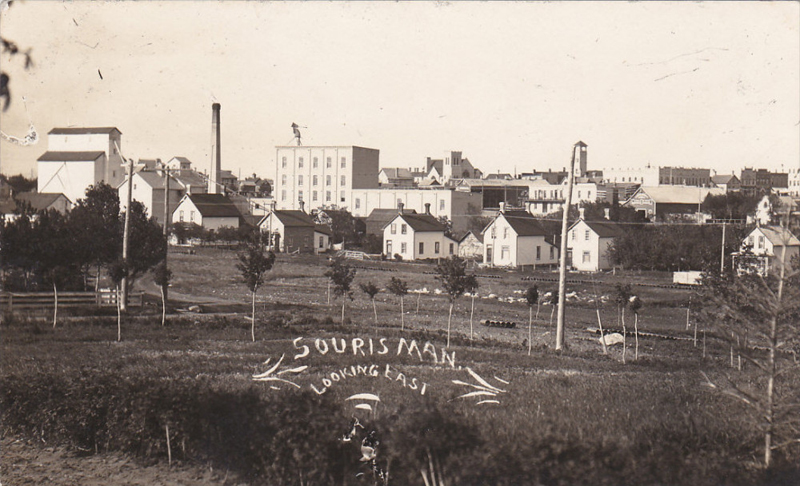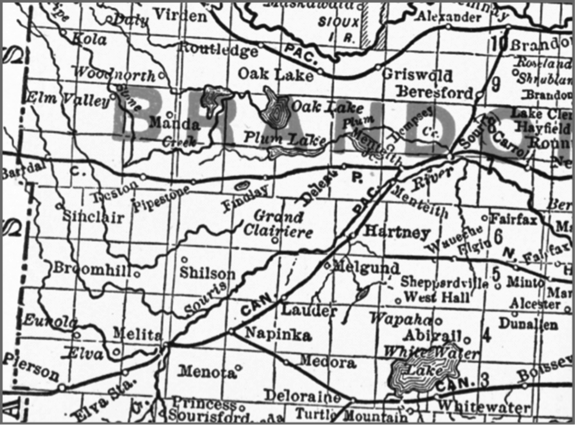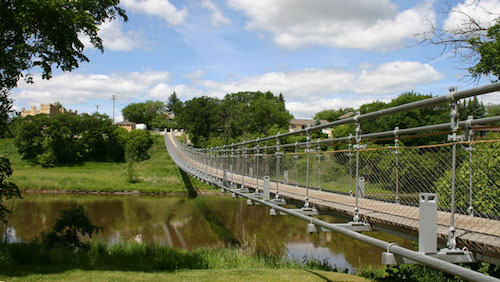|


11: Plum Creek

|
Of
all the riverside settlements in Southwestern Manitoba, the village
of Plum Creek could be said to have been the one situated in the right
spot. There was nothing “False” about this start. Was it good luck,
good timing, or was it just too advantageous a spot to abandon?
You might know it as Souris and although the history that town is well
documented, We will include a very brief note here about its early days.
The first settlers came in 1879, but it was a colonization party from
Ontario that really put the place on the map. In 1880 Squire Sowden
came to look over and consider areas for his settlement. He liked what
he saw and the following year a group he organized known as the
Millwood Colony arrived and set about creating a town.
By 1884 a dam had been built on Plum Creek to provide waterpower for
the mill they had constructed. St. Luke's Anglican Church had been
consecrated, and Breezelawn School was open.
 Photo
courtesy www.prairie-towns.com/
Photo
courtesy www.prairie-towns.com/
By the fall of 1884 there were fifty buildings in the townsite. The
homes of Mr. Sowden, Dr. Stoyte, and J.N. and R.B. Kirchhoffer being
the most elaborate. There were three stores, and four hotels. The
Crescent Hotel, built by Lt. M.S.N. Bryan, a retired Naval Officer, and
operated by Brown and McKennett, was reported to be "the best in style
and first class in all its equipment." The Bruce House, owned and
operated by James Hopkins, also provided a comfortable stopping place.
Jameson and Kirchhoffer's livery stable was reported "equal to the
best."
All that was well in place years before a railway line reached the town
in 1890 and made its future development a certainty.
By then, perhaps it was too big to fail. Was that their strategy?
 Map:
flickr- Manitoba History Collection
Map:
flickr- Manitoba History Collection
Could be, but let’s not discount timing and luck.
The Importance of good timing
Other would-be villages we have described so far existed for only a few
short years before the arrival of railway in the region created a
competing settlement with an incredible advantage. None had become
large enough to offer any incentive to a railway company to alter any
plans. The railway went where it was efficient to do so, and thus
bypassed or ignored villages such as Grand Valley, Millford and Souris
City.
Souris on the other hand, existed for a decade without a rail line, but
also without any competition. The nearest rail line was at the
transcontinental line that ran from Brandon through Griswold. Souris
remained viable; in fact, it prospered as a commercial centre.
A look at the map may also lend some credence to the argument that luck
played a role. When the CPR did decide to build a Branch into the
southwest corner its considerations, as always, rested on two factors.
It sought the most direct and cheapest route. That meant avoiding steep
river valleys, swamps and rugged hills. The other consideration was
maximizing revenue by passing through productive farmland. Essentially
they followed the Souris Valley – where there was good land that was
already producing. They avoided the steep valley at Souris by crossing
the Souris River a bit to the west of town and stayed on the south side
of the river and bypassed places like the Lauder Sandhills. Souris was
right there where it needed to be.
Whatever the interplay of all these factors, Souris not only go its
rail link, it got two and became an important railway centre and the
largest town in the region.

Sources:
The People
of Souris and Glenwood: From the Earliest Beginning to the
Present
Souris and
District Heritage Club Inc. 2006
Early Days
in Souris and Glenwood
by Alice E.
Brown
MHS
Transactions, Series 3, Number 10, 1953-54 season
http://www.mhs.mb.ca/docs/transactions/3/sourisglenwood.shtml
 The
Swinging Bridge - 2018.
The
Swinging Bridge - 2018.

Sowden’s
home is now a Museum.

|
 |
 |
|
|